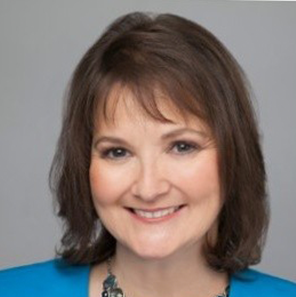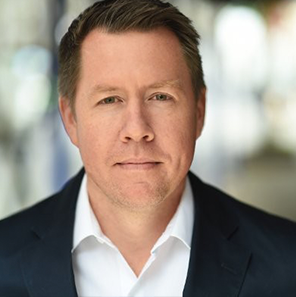Getting Personal: Engagement Personalization
1.9K View | 50 Min Read
Liz Heiman: Hi, I’m Liz Heiman, and some of you may recognize my last name. No, I didn’t write the Miller Heiman programs but I did edit the books. I’m Steve Heiman’s daughter and I came into sales in kind of a different path from all of you. I had no idea there was another alternative, I just thought that’s what everybody did.
So I have a company now that I work with, Alice Heiman, some of you may have seen her earlier, and we help sales organizations grow. Sometimes we help build them and sometimes we help redesign them but what we’re really interested in is, what does it take to support your sales team so that they can create the sales that you want?
I really want to jump into this whole concept of how do you personalize messaging, and how many of you feel like you are just overwhelmed with messaging? How many of you have too many emails? How many of you cannot even keep track of your social media feeds? How many of you don’t even try? Right? We are so bombarded with messaging and if you are on social media, how many of you are getting pop-up messaging that you’re just like, “Oh my gosh, what is this? What is this? Don’t show me this.” We’re so bombarded with messaging. How do we as sellers help you to see a message that we want you to see? And I think that without making that message completely relevant, it doesn’t get through.
So I really want to start in and talk about some of these important things. I want to talk about personalization, why it matters, how to personalize, how much effort it takes, maybe when not to personalize. I’m going to start with Tom.
Before I start with Tom, would you guys each introduce yourselves? Go ahead, sure.
Kirsten Boileau: My name is Kirsten Boileau. I work for SAP, I’m in the global marketing organization and I manage three digital marketing teams, regional engagement, localization, and the social selling program at SAP. I’ve been with SAP for 12 years and I’ve been really focused on developing that personalization with it through our social selling programs and our localization.
Tom Melbourne: Tom Melbourne, I’m head of sales at Sendoso. Sendoso is an engagement delivery platform. So what we do is we help companies source, centralize, and send pretty much anything that you can think of, gifting, direct mail, notes and things like that.
Jake Dunlap: I’m Jake Dunlap, I’m the CEO of Skaled. We are a growth and strategy consulting company. In my previous life, I was the vice president of sales at Glassdoor and a few other startups. We work primarily with growth stage technology companies, helping to build out repeatable processes and understand how to use kind of cutting edge technologies like you see out here. We have built out hundreds of go-to-market strategies, so we can talk all about it.
David Kim: I’m David Kim, the director of sales productivity at Demandbase. Demandbase is an account-based marketing platform. We are currently the leader in this space which is great. We basically help you bring in, generate more demand and traffic from your target accounts and help you close faster.
LH: Great. I want to start with Tom. Tom, tell us about today’s buyer. What do they look like? What matters to them?
TM: Especially in the context of this event, when I think about today’s buyer and personalization, I think a lot of people start to think about the very top of the tunnel piece and really trying to message them in a way that’s personalized to them in a way that they’re going to be able to relate to actually even enter into the funnel, before they get to somebody like me that’s in sales. If you zoom out a little bit more, I think the reason why we’ve had to really personalize more isn’t just so much that we’ve had access to data and are able to do it, but also just because in the market, especially SaaS, when we’re selling software, there’s so much more happening. There are more products, more competitors, and the products are becoming more complex. To be honest with you from a sales perspective, when I think about today’s buyer, I think hopefully we’ve got some good content, we’ve messaged them in a personalized way that they’ve latched onto and come into the funnel. Sometimes though, if we haven’t done the personalization right or they haven’t read enough about it, by the time they get to us they’re actually really confused in some ways.
And so when I think about today’s buyer from a sales perspective, I think personalizing it for them, as a sales rep, we don’t necessarily do enough of. I think just getting into the conversation with the buyer, just being a person again at that point, really engaging with them, understanding why it is that they’re looking at our product, sometimes personalization is just a matter of telling them, “you’ve landed in the right place, I hear your needs, I understand what you’re looking for, all those things you’ve read are true.” Or maybe, “here are some of the things you missed and here are some of the things we can help you out with further,” and just telling them, “you’re our customer and we can really help you with this problem.” At the same time, if you can’t, getting them to understand the things that they missed or maybe another product that would be a better fit for them is a big part of it as well.
LH: Great, thank you. As a buyer, if you think about the buyer journey, we are bombarded and we are lost in all of the technology and all of the messaging. We talk about sales enablement; how do we as an organization help our salespeople help our buyers? Because that’s really what sales enablement is about, helping them find the messaging that helps them make the decisions that they need to make.
So, personalization – how do we strategize, what kind of strategies are there around personalization that helps us to get that messaging right?
JD: Well, I think with personalization, a lot of people think it’s about the company when in reality you’re reaching out to a person. I think the easiest way to show empathy and to personalize is to show that you get their role, you understand what that person is going through. Look, I work with heads of operations, I know these three or four pain points about you specifically and how that’s nuanced based on the subvertical industry that you’re in. I feel like the best way to personalize isn’t, “I know we went to the same college.” I mean, how many of us have got those emails? It worked until everyone started doing it. I feel like the best way to show personalization is really showing that, “I get you, I know what you’re going through, and what that role is going through.”
Whenever we’re building out these strategies, we really think about, how can you personalize to their day-to-day and show that you get it more than anything? People care about themselves first and then their company. If you talk about how we help other companies like yours, it’s not as important as, “I get you.”
LH: “I know the problem that you have, and I want to help you solve it. As a person, as a human being.” Right?
JD: Yeah.
LH: How do we cut through the noise to get there, David? There’s so much messaging, there’s so much noise, how do we cut through it?
DK: In terms of the noise, I think there’s varying different stages for personalization, also. Is it the top of the funnel or are we in the cycle or about to close it? In terms of cutting the noise, we’re focused more on the top side, how are we going to get that meeting, how are we going to shine with that one email out of a hundred emails these people are getting? And I think there are two parts to it, there’s technology and then there’s a soft skill, I think, that needs to be aligned to really cut through that noise. What I mean by that is having tools that provide, for example, an off-site intent – what are they actually interested in off-site, what are they actually researching, and understanding that. Just going to LinkedIn and just looking at their profile is not going to help these days. Like Jake mentioned, everyone’s doing it. How are we going to be different? And I think there’s also beauty in simplicity. We always get these long bulleted emails that have ROI numbers and stats and how many people skim through those? The best emails I’ve gotten are two to three line, really to the point, sometimes even a picture with my name on it, and that stuff is kind of cute, right? I think it’s being very simple and really understanding, to Jake’s point, of who is this person and what is this person interested in? And really hitting that in an email or even a phone call.
LH: Okay. So Kirsten, the next one is for you. What are some of the most creative ways that salespeople can personalize messaging to be heard, to be seen?
KB: I think there are a lot of ways that you can personalize. I mean, sales reps have so many different options in terms of reaching out. They have email, phone, InMail, and PointDrive now and they have so many different options. How do they bring all that together and make it the most personalized they can? I think one of the things that you can use, a tactic you can use, is video. That goes all the way from the top of the funnel through to the end. As you’re closing that deal, you can use video to really drive forward in the relationship, because it’s all about the relationship, right? How you build that relationship, and as you move through the sales cycle with that buyer or group of buyers, you get to know them individually. You get to know them as human beings, as one of you said, and being able to draw on some of that relationship to make those videos even more engaging than they were at the beginning. You use the insights that you’ve gotten to get their attention in the first place, then how do you keep that momentum going in terms of relationship? Video would be one way.
I’ve heard all kinds of different scenarios you can use, things like sending out a gift card for Starbucks for, “Sorry, we missed a meeting” or something like that, and “I’m going to compensate you for your time.” That’s a real way to personalize it and acknowledge that something went wrong. I think Lindsey Boggs was telling me that she cut a Starbucks card in half, sent the other half to a potential client and said, “Meet me in Austin and I will have the other half of this card and we can have a coffee together.” It’s just different ways to personalize it, being very creative, thinking outside the box with things like video, and using different ways to engage in that face-to-face manner.
LH: I want to hear more about creative ideas but before we do that, I want to hear a little bit more about video. How many of you are using video as a way to personalize messaging? Okay. And for those of you who aren’t, why aren’t you? And I just see these kind of uncomfortable smiles.
Emcee: Don’t be shy, who’s got commentary on that? Because one of the things, I’ll speak for my own experiences, is that video really is effective again when it’s personalized but for those of you that aren’t doing it, I’m equally curious.
Audience 1: I think – I’m an account executive by the way – that one of the challenges with video is it’s a personality game. I think it can be really difficult to look at scaling it and try to standardize something like video and saying, “Hey, we’re going to put you in front of your webcam, here’s what you’re going to do.” I don’t know if that’s necessarily fair to do to your entire sales team, I think everyone has different strategies. It’s something that has worked for me, but on the other side of the table, I wouldn’t necessarily expect everyone to.
Emcee: So reading between the lines, it’s about being genuine and authentic to yourself because that connection is really important. I like that. Others who aren’t using it, maybe for another good reason or not good reason?
Audience 2: I have a question. Hi, I’m Caesar, based in San Francisco, just wondering how do you do the mass customization of it? Because if it’s supposed to be personalized, so you’re doing the video to the individual, but how do you do it so that I can now send that same video to a hundred people that day without having to say, “Hi, Joe, Caesar, etc.” Is there a technique for doing that?
KB: Yeah, there are tools out there that you can use that will allow you to do a quick five-second intro and outro but allow you to leverage the content in the middle over and over again. Perhaps it’s a whiteboard video or something like that that shows a particular solution or a particular scenario, and you can personalize that very quickly by creating a five-second introduction: “Hey, Joe, I wanted to share this with you given our conversation yesterday,” and then an outro to say, “I’ll be in touch with you next week to follow up.” Yet it doesn’t take a whole lot of time to do that. We’ve done that, we have a success story at SAP where a sales rep did that, he created 80 of those different videos and he had a 75% return rate. Yes, you want to be able to do it in mass quantity, but if you take the time to do it carefully and well, you can also see the RoI on it.
JD: I think we over-index on volume and repeatability too. If it takes you all day to shoot 50 videos, I can’t pump out 500 activities this week. I think we’ve over-indexed so far, we put volume on a pedestal versus quality and effectiveness. Part of my answer to your question would be if it takes you two days but it’s a higher hit rate, you don’t have to make 45 spam emails or another 200 cold calls. At the end of the day, it’s about effectiveness, not just efficiency, and I think video is just one of the tools like direct mail, etc. Although it may be somewhat less efficient or as easy as clicking a button and sending an email, it’s all about effectiveness; is it working or is it not?
LH: What I’d like to hear a little bit more about is, how do you make those videos effective?
JD: I’ll give my two cents. I think that the biggest issue is that most personalization that I see, and I’d be interested to hear what everyone says, is they personalize the first touch point and that’s it. For example, the first email says something, and then they stop and go straight back to following up with, “Is an elephant sitting on you”, or whatever it is. It’s short, it’s like 30 to 45 seconds. Again, I’m not a big fan, there are some people that talk about holding up your name, there’s been shown that it’ll increase your open rates. If you’re sending that to an SVP, you’re like, “Hi, Rick,” I’m not a big fan of that. Thirty-five seconds, again, really quick, “I work with a lot of XYZ, I know John, I saw these two personalized things, you might be thinking about this, let’s set up 25 minutes, here’s where you can learn some more about me.” Then guess what the next touch point is? Another personalization touch point, whether it’s with video or email. “Maybe you’re not thinking about this, I know you might be doing XYZ, I saw this other thing about you that made me think of you, let’s set up times.” I think it’s got to be short and really easy to consume and just be to the point. Feel free to use the email to try to get it all out.
LH: Alright. David, do you want to share?
DK: I think it sells the teamwork, also. At least at Demandbase, it’s not just a rep who owns the whole personalization, right? The first touch point may be a CSDR, but it’s always teamwork in terms of the reps working together, the solutions engineers working together, even the field marketers working together. Some of the success that we’ve seen is where you’re utilizing direct marketing and even picture and video, knowing when it’s actually going to be delivered to that specific person and sending a video saying, “Did you get it?” or something like that. And also, there’s one more point and I just dropped it.
LH: That’s okay, we’ll get back to you. When you remember you can interrupt.
DK: I’ll come back to it, yes.
TM: I think the thing that everybody’s trying to figure out is how to optimize and scale things a lot and I think that’s sort of the friction point of personalization – how do we scale it now, how do we do a lot of it, and how do we push it out in a large quantity to get a lot of response back? You can’t forget what personalization is. It’s taking the time to really, truly understand somebody and make a connection with them. I think if you’re doing it through video, through emails, through direct mailing, any of the ways that you’re going about doing it, you really need to take that time to actually connect with somebody.
I think when you’re also thinking about personalization, ways that I’ve seen, and I think that it’s done wrong so many times, is that there are only two things about me that people for some reason have latched onto. At one point I was on a website as a chocolate chip cookie connoisseur, and somewhere else I put down that I watch HGTV because I like real estate. And so those are just two funny things I’ve put out there. Well somehow, people find it and the email starts off with like, “Hey, I like chocolate chip cookies too” and it’s like, “Delete.”
At the end of the day, because I know what you’re doing, I’m seeing through it. What I would say to that is, personalization isn’t always just about me, and the thing that I like, but the connection that we’re going to make through that. If it’s something that you really, truly are passionate about and there’s that many of you in the world that want to reach out to me, honestly I’m not that passionate about it, I just like them, so it’s not really something I want to hop on a call and talk to you about. Let’s make sure that if we’re going to make that connection that we genuinely bonded as people and made that connection. There’s a lot of different ways it can be done, but I just think that when you start thinking about trying to do it in scale and you’re really trying to go after it, when you’re doing those types of activities, you’re probably pushing me away more so than connecting with me.
LH: So the more we understand our buyer, the more we think about the individual that we’re talking to, the better able we are to customize. And if we’re trying to customize 80 emails or 80 videos using one message, then maybe it’s not very customized. There’s a balance, there’s a battle between time efficiency and effective messaging. We really have to find that.
We’re going to go back to the question we started with because this was a great little side note, but I want to go back to the question we started with which was what are some creative things that you’ve seen people do that are customized messaging that have been effective?
JD: I think it’s funny – it’s like crickets because it’s so garbage. I think for me, it’s the people that stay after it, it’s the people that consistently show that they’ve researched the company. I think honestly it really is that simple. People who have actually taken the time to think, to Tom’s point, and process what a CEO of a 25 person company is going through, actually took the time to read the website. I really think it’s not rocket science. It literally is, did they take the time, to Tom’s point, to really think about what this person’s going through and customize it, and then they kept at it. It’s personalization plus persistence.
Emcee: I like what you said there, Jake, because I wanted to jump in with my own thoughts on that too. It’s the most effective that I’ve seen – it’s not a one-time thing, it’s a dialogue. It’s important to remember too that while it might seem like a monologue because you’re not getting response or engagement, what’s actually happening having been on the receiving side of it is there’s a relationship that starts to be formed around that. When somebody takes the time and is thoughtful about that, it does resonate over time. I’m glad you brought that piece up.
And let me ask you guys, are there other questions and things that you guys are seeing and struggling with as it relates to personalization? I think mass personalization was a great question. I know where you’re at in the funnel has a big bearing on how much time and effort you want to spend to personalize. But how about you? If you don’t mind, introduce yourselves.
Audience 3: Hi, I’m Bissy Sancimino, I’m from Demandbase Sales Enablement. Jake, I think what you’re saying is really resonating when it comes to showing value to the persona that you’re talking to and taking the 15 minutes to do the research. Two questions: where should we be meeting you, as in over email, by phone, Twitter? I’d love to get your input on that. And also in terms of the research that they’re doing, when it comes to executive priorities and reading LinkedIn articles, understanding the press, what’s going on within that certain company, where are you with fundraising – are there other areas and research that we should be doing and what might those look like?
JD: The answer to the first question is it 100% depends on where your persona lives, meaning we automatically go to our place, LinkedIn, email, cold call. Every single person. And maybe we’ll take a look at Twitter. For us, VPs of sales are some of our targets. They’re not active on Twitter, so guess what? We don’t use Twitter. For other clients, like if they’re selling into media, Twitter is great. My answer to that would be I would just audit. What we typically will do is say, “Look, let’s pick 50 buyers and let’s go look at the channels that they’re on.” Are they active on Instagram, are they active on Facebook, are they active on LinkedIn, no, yes, etc. I just let the data tell us, because for each one of our clients it’s a little bit different, so we kind of try to sculpt it around that.
Again, it’s the same kind of answer for anything interesting. I don’t think enough people capitalize on events – events like this, you know we’re all here. I don’t think people understand how to use events in cadences very well and understanding where people are going to be and how to put an event as part of the cadence, whether it’s attending an event or just understanding where these people actually are physically as well. But I have no opinion, I don’t really care if you use email, call – I have no skin in the game. Like to his point too, I would disagree with his point about how well I would use video or I don’t know if it’s a personal opinion. Why do you care? If your people want video and if it’s working for other people, why wouldn’t every single SDR make videos? I literally can’t even comprehend his answer. If it works then who cares, where’s the ego?
So for me, it’s where do they live, just do the research online, and I’m happy to give you like my two cents on your buyer.
LH: Sales Hacker, if you’re familiar with them, just did a study. I think it’s at SalesHacker/buyer, and they’ve actually done a study with different titles and also different age groups, where they are and how they’re looking for messaging, so some like whitepapers, some like videos, some like webinars. They’ve broken it all down, so if you’re interested in that, I think I’ve got it right but it’s something like that, it’s in the Sales Hacker website. You’re welcome.
KB: I just want to jump in with one other thing. A lot of people do personas, buyer personas, everybody knows what the buyer personas are about. But we’ve taken it one step further and we’re actually doing sentiment analysis and taking surveys and asking them about how they feel about our company, and using that data to try and then align it to: is it a video, is it a case study, is it a whitepaper that they’re going to want, and doing all of that data collection as well, so that might help you out.
LH: I want to move to questions in just a minute. I have just a couple things that I want the panel to address before we do that. One is, I think it kind of ties to what we’ve been talking about. What’s the proper ratio of personalization to effectiveness, like how do you deal with the issue of, we want to do a lot of it or we want to personalize it? What’s the balance? Do we personalize messaging to every single person we reach out to, do we not personalize messaging to every single person we reach out to?
KB: I think you need to figure out where your RoI is. Look at the data for both and decide, are my teams doing so much work and have a ton of activities but their actual return is quite low, whereas the ones who are doing a lot of personalization, they’re not doing as many activities but their RoI is much higher? Or it could be the opposite. You have to do it for yourself. Looking at that in my mind is going to be the best way to go.
DK: I could be biased, since I’m trenched in account-based marketing, which is obviously going after the target accounts where you’re hyper-focused on those target accounts only, and really find the right person. That opens up a lot of time to make things very personal. You can do a lot of personalized messaging, a lot of very personal direct mails. What I’ve noticed and learned a lot from Demandbase’s company marketing is that once you focus on those, you save a lot on your budget because you start cutting out all the fat. Then you have this sort of halo effect of natural marketing that just happens, so your top of the funnel is still there, the traffic is still generated, you just don’t have to throw your money at it to make that happen. If you do practice account-based marketing, account-based sales, there’s a good amount of hyper-focus that you can easily do by focusing on the right target accounts.
LH: This is my last question, we tend to think of personalization at the top of the funnel when we’re having this conversation. Share with me, how does that change, this idea of personalization and including marketing and still being personalized as we move throughout the funnel in the relationship?
TM: This might be off the rails a little bit here, but as I’m listening to this conversation and kind of taking it all in, I think it’s really hard to answer that question because I think at the top of the funnel it’s pretty much impossible to be personal. You can customize things and I think those are the two words that we’re sort of mixing up here. I can look at the buyer persona, I can look at demographics, firmographics, we can serve up intelligent content that we think is going to resonate with them. And I think that that’s customizing it and I think when we call it personalization it’s kind of doing it a disservice of what personalization really is.
I’ll go back to what I said before, which is that it’s really about making a personal connection with somebody and kind of getting to another layer of like, “Hey I get you and I’m going to connect with you around something.” The reason why it’s so hard to answer the question of how do I personalize 500 videos, it’s because you cannot. You can customize them, and I can tailor them to like mentioning your name but I can’t make a personal connection with you in 30 seconds. That really is what it comes down to.
And so again, there isn’t really a shortcut here for me. When you think about it going through the funnel, I just think that it goes from what in the past was never customized. It was just sort of generic and the only way that you got any customization was to talk to a sales rep or somebody to engage in a conversation so that they could take this content and turn it into something that was customized for what you want to see. Now we’ve gotten to the stage of, we can customize it really well and put it out there more, but I think again to get to that personalization piece and moving it all the way down the funnel, you really have to connect with somebody to get to that point.
KB: You have to build those relationships.
TM: Totally, yeah, and the way that you do it is through personal connections, so it’s just like if you separate those two things out for a minute. For me honestly, just on a stage it became a little bit easier to think through that and talk to it in a way, otherwise it’s like how we personalize the top of the funnel and we can sit here all day trying to talk about that but at the end of the day it’s like, who’s on the other end? I don’t know. And we have an idea, we’re going to serve something up to them but whether or not we actually connect on a personal level is going to be really difficult until you get deeper through the process.
LH: And as you get to the bottom of the funnel, you’re no longer customizing. If you don’t actually know that person, why they’re making the decision they’re making, how it impacts their work life, their results, their ability to interact with their employees, the people around them, then you’re not personalizing. You’re still customizing at a point where you should be personalizing.
DK: I just wanted to add that when we think about personalization, at the end of the day the buyers know what they’re doing, they’re buying from a salesperson. The salesperson knows what they’re doing, they’re trying to sell something. There is a deeper connection that could be built from this whole sales cycle but I think the real personalization is for the salesperson to actually understand what the pain point is from the individual who’s talking.
For me, I was a solution consultant for several years before I became a sales productivity person. The discovery process of actually talking to the person is so important because you really have to align the company direction as well as that single person that you’re talking to, what is that person’s motivation for working there and looking for a solution. If you actually understand that, you can have that discovery conversation all the way down to the bottom of the funnel where they say, “Hey, I don’t know if this budget’s going to happen, timeline, etc.” You can go back to that conversation that started this whole thing and say, “What is your backup plan if we don’t hit these three bullets that we talked about in the beginning?” Because at that point as a salesperson, you actually care about this other person making a good mark at their company. And we believe in our product that we’re selling so we can say, “Hey, we can solve that, we can actually make you a superstar, but if you don’t do it now, I get it you don’t have a budget, but what is your backup plan, is it something that we can do?” And I think that’s a real personal connection you make with the actual person that you’re selling to.
LH: Thank you. Now I’m going to open it up, I know there is some interest in asking questions so let’s go ahead and open it up to the floor.
Audience 4: Hi. I have a question about personalization in terms of relating to a person versus, to use your word, a mark in a target company. I mean to me, targeting is a way that you cut through the clutter. But I sort of feel like the right way to create a personal connection with somebody, especially that you’re reaching out cold to is not through, say, “Hey I like chocolate chip cookies too” but rather to say, “Hey, you’re the persona that I want to connect with at a target company of ours, I saw a great news release.” Is that the right way to connect as a member – for them as a mark in a company – at a target company versus trying to personally connect with a person?
JD: I mean, I think so. I think we’re seeing more and more cases that start off with nurture at the beginning too, which is like personalize, nurture, step one, no CTA. Because it used to be every email, every touch point, call to action, so I would answer yes to your question. We’re doing that more and more with our cadences. Follow Tom on LinkedIn, comment on one of his posts. Do something as more of that awareness to his point of trying to establish something. And then, based on some type of trigger or timing then that’s when you go for like the CTAs. I think we’re definitely moving in that direction.
Audience 4: My question is, is the right way to try to connect with –
JD: Jake the employee, not Jake. But again, to Tom’s point, if for the demo you looked at my Instagram and saw I liked the Chiefs and you talked about Patrick Mahomes, I’m like, “All right, that’s cool.” I think it’s easier down there but first, it’s like, I don’t need another friend who likes the Chiefs, can you drive value for my business or not? So I feel like it’s employee toward the top and then I think it gets more, that’s my opinion on it.
TM: I think in the very beginning it’s about getting them to respond to you, getting them to engage with the message that you’re trying to deliver and for your message to stand out and resonate in a way. As soon as I changed my title to the SVP of everybody, the amount of mail, InMail, and emails and just things that I got, it was really overwhelming. And a lot of it’s just the standard, “Hey, here’s what we do for your business” and at the end of the day, if it’s not something that’s top of mind for me right now, I’m probably not going to respond to it. I’ll be aware of it and that’s great but it’s really understanding what is top of mind for me. So here’s a way to think about going about it, it’s like somebody starts a new job at a company, say a VP of sales two months in, and you need to understand the life cycle of a VP of sales coming into a company and the things that they have to start thinking through and working through. It’s like going through those steps and processes and what does your product solve in that pain point and roughly in my life cycle of this position. Have I hit that yet? That actually would be a really great way to try to connect with me because you understand what I’m going through and the position I’m in and trying to get up to speed on a company.
So I think that there are two steps here. I think the first part is just getting somebody to engage with you, to raise their hand and say, “I actually resonate with what you’re saying, this is something that I need, we should talk.” And then the other part of it is connecting, and connecting with me. So now it’s like you’re going to talk to me about, “Hey, what are your OKRs this quarter? What’s going to happen if you miss them? What are you going to do if you don’t get this done? Where are you going to get the budget from? How can I help you in this process?” If I’m two months into the company, “Have you ever bought software before, do we need to team up, are there things I can help out with? Are there other people from my side that I can help bring in? How do I make your life easier?”
And you know if there is a way to connect like, “Hey we both like the Chiefs,” now we can have that dialogue together on something that’s other than that topic and kind of understand how we think about things and the way that we talk about things, and kind of have a little bit of a bond there to help us understand how we also work together and communicate to get you through that sales cycle. I think when you think about it again and it’s more so around getting me to respond first, then we got to connect on the dialogue and that’s to me where personalization actually kicks in. Everything up and to that point isn’t really personalized, it can’t be because we haven’t made that connection.
KB: While she’s getting her question ready, I just wanted to go back to something you said, Jake, about responding to something on somebody’s LinkedIn, something they shared on LinkedIn, and that’s something that we talk a lot about at SAP. Our social selling program is about actually building a relationship before you ever reach out to them. And you can build that relationship on social – I am a social selling professional, so it’s my wheelhouse so I’ll talk about it.
Particularly by asking someone a question, see something they’ve posted on LinkedIn and asking them a question about their opinion on something like that, that gets them engaged, and the question has nothing to do with anything that you want to sell. It’s about building the relationship with them and getting them to talk to you about things that are important to them.
JD: But yeah, don’t come in with a hard ask right after they answer.
KB: Absolutely not.
JD: This is what 92% of salespeople do: “Oh, Johnny responded, now he obviously wants a demo.” No, he doesn’t. It’s like two or three touch points, build some value.
Audience 5: Hi, I’m Bree Valesky, I work at Sendoso with Tom. I wanted to ask, how do you teach this level of personalization to a team of sales reps? How do you help a 25-year-old SDR connect with the CEO of a 25 person company?
Emcee: Or even more difficult maybe is how do you get some of the more old school sellers to start doing personalization and social?
JD: I’m a big fan of customer panels. Actually, when Tom and I worked together like 10 years ago, we sold into a lot of operations groups and I knew the guy who was the VP of operations at McKesson and we went to the warehouse where they ship everything and had him sit down and we talked to him. When I was a front line sales leader, I would reach out to those people and I’d have them come and talk to my team about what I’m going through. And I think that helps the wheels turn for them a lot more than the buyer persona, so I’m a big fan of thinking of customers as prospects and actually talking about what they do.
LH: I’m going to answer that as well. One of the things that we do is coach. So if we want our salespeople to have certain results, we have to ask the right questions and coach them around it. And one of the most important things you can do is continually ask, “What problem is this person having and how can we help them solve it?” And you would be surprised how often our sales reps can’t answer that question even about people they’ve been talking to for a very long time. So it’s keeping our sales reps focused on problems. What does this person care about, what do they want to achieve, what’s important to them? Instead of what’s our product, what are our features, what can we do for you? We have to change the conversation.
Emcee: Tom, I have to imagine that question was partially aimed at you, given where it came from, but I’m wondering, is she actually asking that for a different reason? You haven’t said anything.
TM: I’ll see her after, I feel like we could chat more in detail then.
How do you train them up on it? I think it’s an orchestration of everything. I think to Jake’s point it’s like if you get these reps or whoever it is you’re trying to train up really familiar with what they’re actually doing, and that’s something that I think I see more and more of as I’ve kind of grown up through sales. When I was on the floor doing this stuff, the sales tools we had, they weren’t around, and so I think especially a lot of SaaS companies, we’re all out there competing really fast, competition comes in really quick.
We’re all focused around just trying to get to the next sale and be optimized and do it in a way that’s cost-effective and all these things that we’re going against. And I think a lot of the training now is more so on how to run the tool and how to run the cadence versus when we actually just get into learning how to sell it. And learning how to sell it is that point of really understanding who’s buying it. I think these products are becoming more complex, I think they become more of a platform.
The hardest product to sell is the one that can do anything for anybody so it does nothing for anybody. It’s really honing in on that persona and understanding and if you have one of those products, what is the segment that you want somebody really focused in on and what are the pains that they’re having? What’s a day in the life of that person like? How do we talk to them in that way? So I think just the training kind of comes in around that, it’s like, let’s stop focusing so much on training and tools and start focusing more on just actually selling and who we’re selling to and making those connections, connecting our product to what it is that they’re trying to do.
Emcee: Good question, good job putting your VP of sales on the spot.
Audience 6: I’ve got a question. We’ve been talking about scalability and how to reach out. I’d like to ask the panelists, is there any artificial intelligence email tools that you’re aware of that can do an effective job doing that first screen, that first touch?
Emcee: So is that something like, “Alexa, please send my email for me?”
Audience 6: The scenario I’m imagining in my head is you do an outreach campaign, they fill out their form and say, “okay, here’s my contact information, you’re free to contact me”, but as far as determining that screen of whether or not it makes sense for a human to make that touch. A lot of people are advocating this artificial intelligence to send that initial email out and I’m just curious what the panel thinks about that.
JD: When they come inbound, is that what you’re saying? Someone fills something out? I like Drift, I think what Drift is doing is pretty interesting. But yeah, I’m a big fan. Do you really want to talk to a person in the first touch point? No. I just want to get information. I think, especially for more transactional sales, less than $10,000, $5,000 a year, most of it’s going to be. I don’t want to talk to a person, I’d rather talk to a bot. I’m dead serious, like, do not try to schedule a demo with me. Qualify me, you know if I’m a good fit or not. I think what Drift’s doing is pretty cool and I think the bots for sure are going to start to get better and better, especially at like SMB level of the market.
Emcee: One more question? Any other questions? One more from the back? You already got your beer, how’d that happen?
Audience 7: Sneaky. Only if no one else has already gone. I know Tom’s answer but I’m curious, David, Kirsten, and Jake, have you guys thought about changing the way that you compensate or incentivize your sales involving people to put an emphasis on either personalization or just those target accounts instead of just calling all meetings equal?
JD: I’ll just tell you our recipe. We’re trying to move a lot of our clients away from tracking activities. And what I mean by that is, we’re moving the first thing that you track to the first outcome, which would be like a meaningful conversation. I think that you can define that pretty clearly because activities alone don’t track now that we use LinkedIn to try to do some of the things we’re talking about. That doesn’t show up on my activities sheet, but I’ve been told for the past 10 years, “Jake, I’ve got to go make whatever number of activities” as opposed to producing the beginning of the outcome to get an appointment or qualified meeting, which is that. So for us, I still like the compensation as kind of a qualified opportunity. I still like percent of deal, but to me, it’s more about, what am I actually measuring so the SDRs are incentivized to do the right things in the day-to-day, as opposed to going and call 25 fake numbers and fax machines to get their talk time up.
KB: From SAP’s perspective, I can’t talk about compensation, it’s not my area of expertise at SAP. But in our social selling program, we have developed an analytic solution that allows us to tie in the SSI, the Social Selling Index, with actual sales performance metrics such as beyond revenue and pipeline, more around time to close than acceleration rates and conversion rates and conversion value and volume, that kind of thing. We actually launched that at the Sales Enablement Society conference last week.
And then from that data, we’re able to identify some key indices from there where we can then do some diagnostics and help coach sales reps that perhaps are falling behind in that area, and learn from those that are really doing well and perhaps above the index, learning from those and helping them so they can do peer-to-peer communication and coaching, to someone’s question about training. But then the sales manager also will have access to that data to look at his own team and be able to compare himself and his team to other like-teams in either his region, his market unit, and be able to leverage that information perhaps to do some compensation evaluation.















